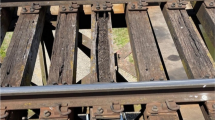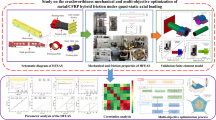Abstract
Railway bridges are susceptible to over-height truck collisions and to address this issue, it is necessary to attenuate the effect of these impacts to ensure the safety of transportation operations. This study experimentally investigates the effectiveness of crash beams as a cushioning mechanism for railway bridges against collisions. Over-height truck and railway bridge impact events were simulated in a 1:5 scale experiment. The design parameters such as the stiffness of the crash beam and the bridge supports were scaled to evaluate different levels of attenuation. Seventeen experiments were conducted with five configurations consisting of four different types of crash beams and one no-crash beam arrangement. The results show that crash beams attenuate bridge total peak dynamic displacement responses between 14.5% and 35.7%, depending on the intensity of the impact and crash beam type. In addition, the results show that the average effectiveness in attenuating residual deformation for all four crash beams ranges from 43.03% to 83.40%. Finally, various designs and their effectiveness against lateral impacts with different speeds are discussed. The overall scope of this research is to provide objective information about the design of crash beams for railway bridges based on their response to over-height truck collisions at various speeds.
Similar content being viewed by others
References
Alam MI, Fawzia S and Zhao XL (2016), “Numerical Investigation of CFRP Strengthened Full Scale CFST Columns Subjected to Vehicular Impact,” Engineering Structures, 126: 292–310.
Buth CE, Williams WF, Brackin MS, Lord D, Geedipally SR and Abu-Odeh AY (2010), “Analysis of Large Truck Collisions with Bridge Piers: Phase 1,” Report of Guidelines for Designing Bridge Piers and Abutments for Vehicle Collisions (No. FHWA/TX-10/9-4973-1), Texas: Texas Transportation Institute, USA.
Buth CE, Brackin MS, Williams WF and Fry GT (2011), “Collision Loads on Bridge Piers: Phase 2,” Report of Guidelines for Designing Bridge Piers and Abutments for Vehicle Collisions (No. FHWA/TX-11/9-4973-2), Texas Transportation Institute, USA.
Butterfield R (2001), “Dimensional analysis revisited,” Proceedings of the Institution of Mechanical Engineers, Part C: Journal of Mechanical Engineering Science, 215(11): 1365–1375.
China Railway (2014), Regulations on Railway Technical Management, China Railway Publish House, Beijing, China. (in Chinese)
Fu C, Burhouse J and Chang GL (2004), “Overheight Vehicle Collisions with Highway Bridges,” Transportation Research Record, 1865: 80–88.
GB 50081-2002 (2002), Standard for Test Method of Mechanical Properties on Ordinary Concrete, Ministry of Housing and Urban-Rural Development of the People’s Republic of China, China Architecture & Building Press, Beijing, China. (in Chinese)
GB/T 228-2002 (2002), General Administration of Quality Supervision, Inspection and Quarantine of the People’s Republic of China Metallic Materials-Tensile Testing at Ambient Temperature, China Metrology Publishing House, Beijing, China. (in Chinese)
Gharad AM and Sonparote RS (2021), “Evaluation of Vertical Impact Factor Coefficients for Continuous and Integral Railway Bridges Under High-Speed Moving Loads,” Earthquake Engineering and Engineering Vibration, 20(2): 495–504. https://doi.org/10.1007/s11803-021-2034-7
Hanchey CM and Exley SF (1990), “Overheight Vehicle Warning Systems in Mississippi,” ITE Journal, 60(6): 24–29.
Harik IE, Shaaban AM, Gesund H, Valli GYS and Wang ST (1990), “United States Bridge Failures, 1951–1988,” Journal of Performance of Constructed Facilities, 4(4): 272–277.
Hite MC (2007), “Evaluation of the Performance of Bridge Steel Pedestals Under Low Seismic Loads,” PhD Thesis, School of Civil and Environmental Engineering, Georgia Institute of Technology, USA.
Jing Y, Ma ZJ and Clarke DB (2016), “Full-Scale Lateral Impact Testing of Prestressed Concrete Girder,” Structural Concrete, 17(6): 947–958.
Joy R, Jones MC, Otter D and Maal L (2013), “Characterization of Railroad Bridge Service Interruptions,” Transport Research International Documentation — TRID (No. DOT/FRA/ORD-13/05), Accessed February. https://rosap.ntl.bts.gov/view/dot/26244
JTG D60-2004 (2004), General Code for Design of Highway Bridges and Culverts, Ministry of Transport of the People’s Republic of China, China Communications Press, Beijing, China. (in Chinese)
Kish A and Samavedam G (1991), “Dynamic buckling of Continuous Welded Rail Track: Theory, Tests, and Safety Concepts,” Transportation Research Record, 1289(1991): 23–38.
Kong L, Zhang J and Han W (2020), “Investigation on Damage and Simplified Collision Force of Prestressed Concrete Box Bridge Subjected to Over-Height Truck Collision,” 2020 International Conference on Intelligent Transportation, Big Data & Smart City (ICITBS), Vientiane, Laos, 37–42. https://doi.org/10.1109/ICITBS49701.2020.00016
Liang Z and Lee GC (2013a), “Bridge Pier Failure Probabilities Under Combined Hazard Effects of Scour, Truck and Earthquake. Part I: Occurrence Probabilities,” Earthquake Engineering and Engineering Vibration, 12(2): 229–240.
Liang Z and Lee GC (2013b), “Bridge Pier Failure Probabilities Under Combined Hazard Effects of Scour, Truck and Earthquake. Part II: Failure Probabilities,” Earthquake Engineering and Engineering Vibration, 12(2): 241–250.
Low Clearances (2018), http://www.lowclearances.com/. (accessed October 14, 2018)
Lu XZ, Zhang YH, He ST and Lu X (2009), “Collision Between Over-High Truck and Bridge Superstructures: Damage Mechanism and Impact Loads,” Engineering Mechanics, 2009(S2): 115–125. (in Chinese)
Network Rail (2017), The Risk of Bridge Strikes, Accessed January 30, 2018. https://www.networkrail.co.uk/running-the-railway/looking-after-the-railway/bridges-tunnels-viaducts/risk-bridge-strikes/
Nguyen B, Brilakis I and Vela PA (2017), “Optimized Parameters for Over-Height Vehicle Detection Under Variable Weather Conditions,” Journal of Computing in Civil Engineering, 31(5): 04017039. https://doi.org/10.1061/(ASCE)CP.1943-5487.0000685
Ozdagli AI, Moreu F, Xu D and Wang T (2020), “Experimental Analysis on Effectiveness of Crash Beams for Impact Attenuation of Overheight Vehicle Collisions on Railroad Bridges,” Journal of Bridge Engineering, 25(1): 04019133. doi:https://doi.org/10.1061/(asce)be.1943-5592.0001503
Qiao P, Yang M and Mosallam AS (2004), “Impact Analysis of I-Lam Sandwich System for Over-Height Collision Protection of Highway Bridges,” Engineering Structures, 26(7): 1003–1012.
Sharma H, Hurlebaus S and Gardoni P (2008), “Development of a Bridge Bumper to Protect Bridge Girders from Overheight Vehicle Impacts,” Computer-Aided Civil and Infrastructure Engineering, 23(6): 415–426.
Tabatabai H and Nabizadeh A (2019), “Strength and Serviceability of Damaged Prestressed Girders,” WisDOT ID No. 0092-17-02, University of Wisconsin- Milwaukee, USA. Accessed May. https://www.researchgate.net/profile/Habib_Tabatabai/publication/333520686_Strength_and_Serviceability_of_Damaged_Prestressed_Girders/links/5d23a841458515c11c1f38a9/Strength-and-Serviceability-of-Damaged-Prestressed-Girders.pdf
U.S. Department of Transportation Federal Railroad Administration (2013), “Characterization of Railroad Bridge Service Interruptions,” Report No. DOT/FRA/ORD-13/05, Accessed February.
U.S. Department of Transportation Federal Highway Administration (FHWA) (2015), Status of the Nation’s Highways, Bridges, and Transit: Conditions and Performance Report to Congress, https://www.fhwa.dot.gov/policy/2015cpr/pdfs/2015cpr.
U.S. Department of Transportation Federal Highway Administration (FHWA) (2019), Advanced Transportation & Congestion Management Technologies Deployment (ACTMTD) Proposal: Next Generation Management of the I80 Corridor for Bridge Performance, Damage, and Load Capacity. https://ops.fhwa.dot.gov/fastact/atcmtd/2017/applications/iowadoti80/project.htm
Vemuganti S, Moreu F, Ozdagli AI, Bajri’c A, Liu B, Troyer K, Brake MR and Otter D (2017), “Sensing and Rating of Vehicle—Railroad Bridge Collision,” Structural Dynamics Challenges in Next Generation Aerospace Systems, IMAC XXXV. New York: Springer.
Wardhana K and Hadipriono FC (2003), “Analysis of Recent Bridge Failures in the United States,” Journal of Performance of Constructed Facilities, 17(3): 144–150.
Xu LJ, Lu XZ, Smith ST and He ST (2012), “Scaled Model Test for Collision Between Over-Height Truck and Bridge Superstructure,” International Journal of Impact Engineering, 49: 31–42.
Acknowledgment
This study was funded by the Scientific Research Fund of Institute of Engineering Mechanics, China Earthquake Administration (2016A06 and 2017A02); the National Natural Science Foundation of China (51678538 and 51878630); the Transportation Consortium of South-Central States (TRANSET); and U.S. Department of Transportation (USDOT), Project No. 17STUNM02. Support from the Department of Civil, Construction and Environmental Engineering and the Center for Advanced Research and Computing (CARC) at the University of New Mexico is also appreciated. The authors thank the Canadian National Railway for providing critical input during the development of this study, in particular, Sandro Scola. The interpretation of the results obtained from this study are solely the opinion of the authors.
Author information
Authors and Affiliations
Corresponding author
Additional information
Supported by
Scientific Research Fund of Institute of Engineering Mechanics, China Earthquake Administration under Grant Nos. 2016A06 and 2017A02, the National Natural Science Foundation of China under Grant Nos. 51678538 and 51878630, the Transportation Consortium of South-Central States (TRANSET), and US Department of Transportation (USDOT), Project No. 17STUNM02
Rights and permissions
About this article
Cite this article
Xu, D., Yuan, X., Ozdagli, A.I. et al. Over-height truck collisions with railway bridges: attenuation of damage using crash beams. Earthq. Eng. Eng. Vib. 21, 237–252 (2022). https://doi.org/10.1007/s11803-022-2081-8
Received:
Accepted:
Published:
Issue Date:
DOI: https://doi.org/10.1007/s11803-022-2081-8




